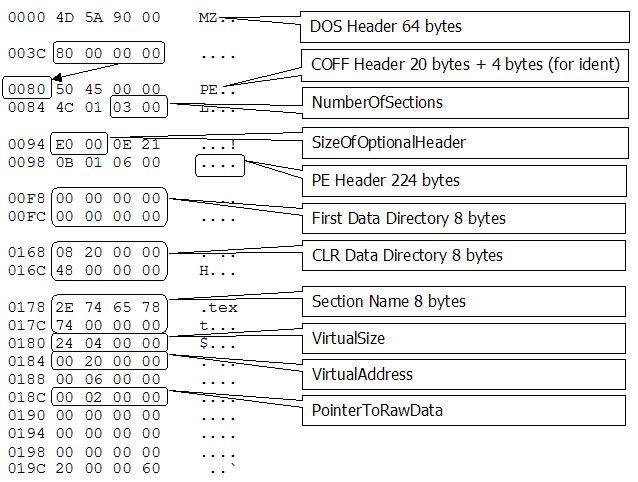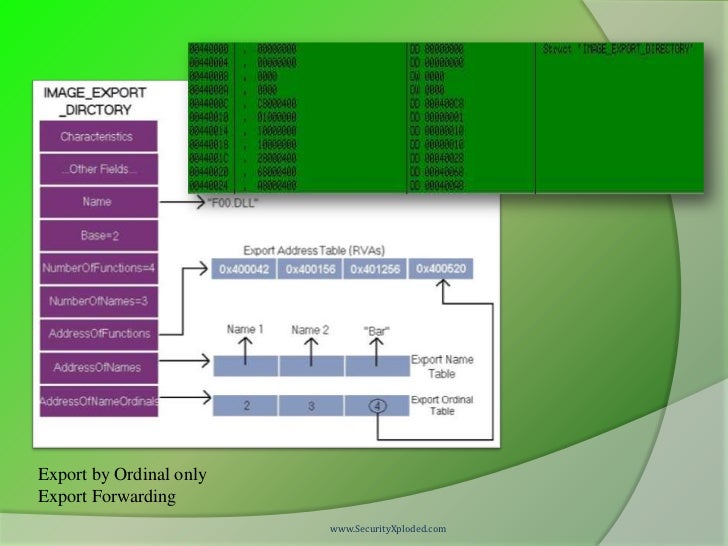
- The PE File Extension are listed predominantly as Executable Files, while in other circumstances they can be Plugin Files or Data Files. We have found PE files on the Windows operating system platform.
- Portable Executable (PE) file format is a file format for executable / dll files introduced in Windows NT. It's based on COFF (Common Object File Format) specification. To remain compatible with previous versions of the MS-DOS and Windows, the PE file format retains the old MZ header from MS-DOS.
- A Portable Executable (PE) file is the standard binary file format for an Executable or DLL under Windows NT, Windows 95, and Win32. The Win32 SDK contains a file, winnt.h, which declares various structs and variables used in the PE files. Some functions for manipulating PE files are also included in imagehlp.dll.
- Comparison of executable file formats. In addition to the binary application code, the executables may contain headers and tables with relocation and fixup information as well as various kinds of meta data. Among those formats listed, the ones in most common use are PE (on Microsoft Windows ), ELF (on Linux and most other versions of Unix ), Mach-O (on macOS and iOS) and MZ (on DOS ).
When the download is complete, double-click the download file to run the installation wizard. Follow the on-screen instructions to complete the installation. Run ISO2Disc program. Locate your ISO image file, then select your target device: CD/DVD or USB flash drive. Click the Start Burn button to start creating a bootable Windows PE bootdisk. The Portable Executable (PE) format is a file format for executables, object code, DLLs, FON Font files, and others used in 32-bit and 64-bit versions of Windows operating systems. The PE format is a data structure that encapsulates the information necessary for the Windows OS loader to manage the wrapped executable code. Jul 26, 2018 When looking at an EXE file, one has to decide which memory model was used to build that file. A Portable Executable (PE) file is the standard binary file format for an Executable or DLL under Windows NT, Windows 95, and Win32.
This is a comparison of binary executablefile formats which, once loaded by a suitable executable loader, can be directly executed by the CPU rather than become interpreted by software. In addition to the binary application code, the executables may contain headers and tables with relocation and fixup information as well as various kinds of meta data. Among those formats listed, the ones in most common use are PE (on Microsoft Windows), ELF (on Linux and most other versions of Unix), Mach-O (on macOS and iOS) and MZ (on DOS).
| Format name | Operating system | Filename extension | Explicit processor declarations | Arbitrary sections | Metadata[a] | Digital signature | String table | Symbol table | 64-bit | Fat binaries | Can contain icon |
|---|---|---|---|---|---|---|---|---|---|---|---|
| OS/360 | OS/360 and successors, and VS/9, mainframe operating systems | none | No | No | No | No | No | Yes | Yes | No | No |
| GOFF | IBM MVS and z/OS mainframe operating systems | none | No | No | Yes | No | Yes | Yes | Yes | No | No |
| a.out | Unix-like | none | No | No | No | No | Yes[1] | Yes[1] | Extension | No | No |
| COFF | Unix-like | none | Yes by file | Yes | No | No | Yes | Yes | Extension | No | No |
| ECOFF | Ultrix, Tru64 UNIX, IRIX | none | Yes by file | Yes | No | No | Yes | Yes | Yes | No | No |
| XCOFF | IBM AIX, BeOS, 'classic' Mac OS | none | Yes by file | Yes | No | No | Yes | Yes[2] | Yes | No | No |
| ELF | Unix-like, OpenVMS, BeOSfrom R4 onwards, Haiku | none | Yes by file | Yes | Yes | Yes[3] | Yes | Yes[4] | Yes | Extension[5] | Extension[6] |
| Mach-O[7] | NeXTSTEP, macOS, iOS, watchOS, tvOS | none | Yes by section | Some (limited to max. 256 sections) | Yes | Yes | Yes | Yes | Yes | Yes | No |
| SOM | HP-UX, MPE/ix | ? | Unknown | Unknown | No | No | Unknown | Yes | No | Unknown | No |
| Amiga Hunk | AmigaOS | none | No | Yes | Yes | No | No | Yes | No | Yes | No |
| PEF[8] | 'classic' Mac OS, BeOS(PPC only) | none | Yes by file | No | No | No | Yes | Yes | No | No | No |
| CMD | CP/M-86, MP/M-86, Concurrent CP/M-86, Personal CP/M-86, S5-DOS, Concurrent DOS, Concurrent DOS 286, FlexOS, S5-DOS/ST, S5-DOS/MT, Concurrent DOS 386, Multiuser DOS, System Manager, REAL/32, DOS Plus | .CMD | No (x86 only) | Yes | No | No | Extension | Extension | No | No | No |
| FlexOS 186 | FlexOS 186, FlexOS 286, S5-DOS/ST, S5-DOS/MT, 4680 OS, FlexOS 386, 4690 OS | .186 | No (186/188 and higher only) | Yes | No | No | Extension | Extension | No | No | No |
| FlexOS 286 | FlexOS 286, S5-DOS/ST, S5-DOS/MT, 4680 OS, FlexOS 386, 4690 OS | .286 | No (286 and higher only) | Yes | No | No | Extension | Extension | No | No | No |
| CP/M-68K | CP/M-68K, Concurrent DOS 68K, FlexOS 68K | .68K | No (68000 and higher only) | Yes | No | No | Unknown | Unknown | No | No | No |
| COM (CP/M) | CP/M, MP/M, Concurrent CP/M, Personal CP/M | .COM | No (8080/Z80 only) | Extension (BDOS 3 and higher only) | No | No | No | No | No | Extension | No |
| COM (DOS) | DOS, OS/2, Windows(except for 64-bit editions), Concurrent CP/M-86(BDOS 3.1 only), Concurrent DOS, Concurrent DOS 286, FlexOS, Concurrent DOS 386, Multiuser DOS, System Manager, REAL/32, DOS Plus | .COM | No (x86 only) | No | Extension (Novell/Caldera VERSION etc.) | No | No | No | Extension | Extension | No |
| MZ (DOS) | DOS, OS/2, Windows(except for 64-bit editions), Concurrent DOS 286, FlexOS, Concurrent DOS 386, Multiuser DOS, System Manager, REAL/32, DOS Plus | .EXE | No (x86 only) | Yes | Extension(Novell/Caldera VERSION etc.) | No | Extension | Extension | Extension | No | No |
| MZ (GEM) | GEM, ViewMAX | .APP/.ACC | No (x86 only) | Yes | No | No | Unknown | Unknown | No | No | Unknown |
| NE | MS-DOS 4.0 (multitasking), OS/2, Windows, HX DOS Extender | .EXE | Unknown | Unknown | Unknown | No | Unknown | Unknown | No | No | Yes |
| LE, (W3, W4) | OS/2(2.0 and higher only), some DOS extenders | .EXE | Yes by file (286 and higher only) | Yes | Yes | No | Yes | Yes | No | No | Yes |
| LX | OS/2(2.0 and higher only), some 32-bit DOS extenders | .EXE | Yes by file | Yes | Yes | No | Yes | Yes[9] | No | No | Yes |
| PE | Windows, ReactOS, HX DOS Extender, BeOS(R3 only) | .EXE | Yes by file | Yes | Yes | Yes[10] | Yes | Yes | No | No | Yes |
| PE32+ | Windows(64-bit editions only) | .EXE | Yes by file | Yes | Yes | Yes | Yes | Yes | Yes | Yes[11] | Yes |
| PIM/XIP | PalmDOS(MINIMAX applications only) | .PIM/.XIP | No (x86 only) | Yes | No | No | No | No | No | No | No |
| DL | MS-DOSSystem Manager applications (HP LX series only) | .EXM | No (186/188 and higher only) | Yes | No | No | No | No | No | No | No |
| MP | .EXP | Unknown (286 and higher only) | Yes | No | No | Unknown | Unknown | No | No | No | |
| P2 | Phar Lap 16-bit DOS extenders | .EXP | Unknown (286 and higher only) | Yes | No | No | Unknown | Unknown | No | No | No |
| P3 | Phar Lap 32-bit DOS extenders | .EXP | Unknown (386 and higher only) | Yes | No | No | Unknown | Unknown | No | No | No |
| GEOS | PC/GEOS, Geoworks Ensemble, NewDeal Office, Breadbox Ensemble | .GEO | Unknown (x86 only) | Unknown | Unknown | No | Unknown | Unknown | No | No | Unknown |
Notes[edit]
- ^
- Metadata is casually used to describe the controlling data used in software architectures that are more abstract or configurable. Most executable file formats include what may be termed 'metadata' that specifies certain, usually configurable, behavioral runtime characteristics. However, it is difficult if not impossible to precisely distinguish program 'metadata' from general aspects of stored-program computing architecture; if the machine reads it and acts upon it, it is a computational instruction, and the prefix 'meta' has little significance.
- In Java, the class file format contains metadata used by the Java compiler and the Java virtual machine to dynamically linkclasses and to support reflection. The Java Platform, Standard Edition since J2SE 5.0 has included a metadata facility to allow additional annotations that are used by development tools.
- In MS-DOS, the COM file format does not normally include metadata, while the EXE file and Windows PE formats do. These metadata can include the company that published the program, the date the program was created, the version number and more.
- In the .NET Framework executable format, extra metadata is included to allow reflection at runtime.
References[edit]
Windows Pe File Structure

- ^ ab'a.out(5) - FreeBSD Man Pages'. Freebsd.org. 10 June 2010. Retrieved 9 July 2012.
- ^'Files Reference – XCOFF Object File Format'. IBM.
- ^'elfsign – Freecode'. Freshmeat.net. Retrieved 9 July 2012.
- ^'(3elf) - Elf library routines'. Uw714doc.sco.com. 25 April 2004. Retrieved 9 July 2012.
- ^'FatELF: Universal Binaries for Linux'. Icculus.org. Retrieved 9 July 2012.
- ^'ElfIcon: Icons for ELF files'. Compholio.com. Retrieved 9 July 2012.
- ^'Mac OS X ABI Mach-O File Format Reference'. Apple Inc. 4 February 2009. Retrieved 9 July 2012.
- ^'MPW Command Reference - DumpPEF'. Apple Inc. Archived from the original on 12 May 2008.
- ^'LX - Linear eXecutable Module Format Description'. 3 June 1992. Retrieved 7 July 2019.
- ^'Windows Authenticode Portable Executable Signature Format'. Microsoft. 29 August 2008. Retrieved 9 July 2012.
- ^'WOW64 Implementation Details'. Microsoft. 31 May 2018. Retrieved 5 September 2018.